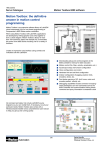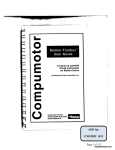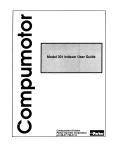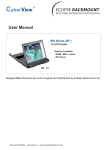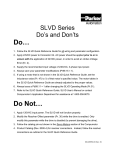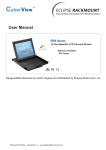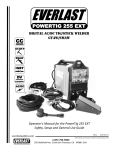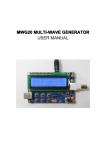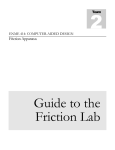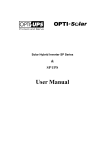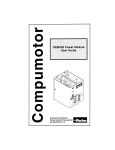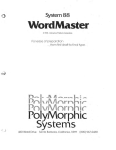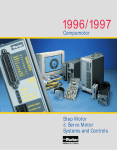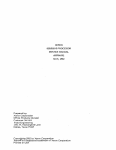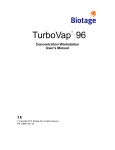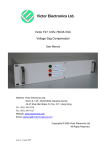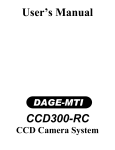Download Chapter 7. MAINTENANCE
Transcript
CHAPTER 7. MAINTENANCE & TROUBLESHOOTING Chapter 7. MAINTENANCE & TROUBLESHOOTING Chapter Objectives Mai ntenance The infonnatlon In this chapter wUl enable you to: • Maintain the system's components to ensure smooth. efficient operation • Isolate and resolve system hardware and software problems • Use this chapter as a quick reference tool for a description of system error codes The following system components require periodic maintenance: • • Spare Parts Table 189 The Motor The Drive Table 7-1 provides a list of recommended spare parts to use with the AX. system. Part DescrlDtion Choice of two drives: AXH AXL Mechanical Screws (6-32 x 1/4) Universal Mountina Bracket 5-Position Terminal Connector Phoenix 6-Position Terminal Connector, Phoenix 8-Position Terminal Connector, Phoenix 11-Position Terminal Connector, Phoenix Fan Kit (standard on AXH Drives) Part Number AXH-DRIVE AXL-DRIVE 51-006037-01 53-006007 -01 43-005561-01 43-006606-01 43-006786-01 43-007085-01 AFK Table 7-1. Recommended Spare Parts for the AX System 190 AX DRIVE USER GUIDE Motor Maintenance You should inspect all mechanical parts of the motor regularly to ensure that no bolts or couplings have become loose dUring normal operation. This will prevent minor problems from developing into more serious problems. The ball bearings used in the Compumotor-supplied motors are not sealed against severe environments. but are permanently lubricated and do not require any maintenance. You should inspect the motor cables periodically for signs of wear. This inspection inteIVal is duty-cycle. environment. and travel-length dependent. You should not apply excessive tensile force to the cable. Do not bend the cable beyond a oneinch radius of CUIVature during normal operation. Tighten all cable connectors. Drive Maintenance Troubleshooting Problem Isolation Check that the drive heatsink is free of particles and has a free flow of air over its entire surface. Enclosures must be connected to earth ground through a grounding electrode conductor to provide a low-impedance path for ground-fault or noise-induced currents. All earth ground connections must be continuous and permanent. This section discusses methods to identify. isOlate. and resolve problems that may occur with your AX Drive. When your system does not function properly (or as you expect it to operate), the first thing that you must do is identify and isolate the problem. When you accomplish this. you can effectively begin to eradicate and resolve the problem. Try to determine if the problem is mechanical. electrical. or software-related. Can you repeat or re-create the problem? Do not attempt to make quick rationalizations about problems. Random events may appear to be related. but they are not necessarily contributing factors to your problem. You must carefully investigate and decipher the events that occur before the subsequent system problem. You may be experiencing more than one problem. You must solve one problem at a time. Log (document) all testing and problem isolation procedures. You may need to review and consult these notes later. This will also prevent you from duplicating your testing efforts. Isolate each system component and ensure that each component functions properly when it is run independently. You may have to remove your system components and reinstall them component-by-component to detect the problem. If you have additional components available. you may want to use them to replace existing components in your system to help identify the source of the problem. CHAPTER 7. MAINTENANCE & TROUBLESHOOTING 191 Once you have isolated the problem. take the necessary steps to resolve it. Refer to the problem solutions contained in this chapter. If your system's problem persist. contact Parker Compumotor's Applications Department at (800) 358-9070. Motor Falls to Move Test the motor to see if it has holding torque. If there is no holding torque. here are some probable causes: • There is no AC power. • Current selection DIP switches are not set properly (see the motor current selection table in Chapter 6. Hardware Reference). • There are bad connections or bad cables. Disconnect the power connector. then use an ohm meter to monitor continuity between the motor-to-drive cable. • The drive may be disabled through software (STI command). If the unit has holding torque and the motor shaft still fails to move. here are some probable causes: • The limit switches have been tripped or are faulty. Make sure that your limit switches are OFF or that the limits are disabled (LD3 command). • The load is jammed. You should hear the drive attempting to move the motor. Remove AC power from the drive and verify that you can move the load manually away from the point of the jam. • Indexer parameters are Incorrectly set up. If certain parameters are out of range or are missing. the motor will not move when you issue the Go (G) command. Use R. RA. RB. and RS status commands to detennine what is preventing the move. Also check A. V. and D commands to make sure that all the parameters are set properly. The following are additional troubleshooting techniques: • Check the motor for damage. Also check the motor cable to see if it is damaged or shortened. These conditions may cause the drive to fault. • Ohm the motor and cables to make sure that short-circuits do not exist between phases or to earth GND. On your most sensitive scale. the resistance across each motor phase should be conSistently low (but not zero) and similar to each other. On your highest scale. the resistance between motor phases and between each phase and earth ground should be infinite. 192 AX DRIVE USER GUIDE Fault LED Motor Stalls There is a red FAULT LED located on the connector-side of the AX dIive. The LED may be activated (illuminated) if one of the following conditions exists: • Shutdown: You commanded the drtve to shutdown. Use the Sn!) command to tum the drtve on again. • Over-temperature: The drive may be overheating (heatsink temperature is above 149°F (65°C). You may conSider cooling the drive and/or enclosure. Installing a fan kit on the drive would help the problem. • Short-circuit: A short-circuit exists in the motor current output. Use an ohm meter to make sure that there is not a short-circuit between phase A. phase B. or to earth ground. NOTE: Make sure power has been removed fHd'ore you test the motor. • Brown-out: Check the AC input voltage to make sure that the drive is receiving more than 95VAC. A motor stall during acceleration may be caused by one or more of the following factors: • • • The torque requirements may be excessive The acceleration ramp may be too steep The load inertia and motor inertia may be grossly mismatched. Lower acceleration may be required. If the motor stalls during the constant velocity portion of a move. the shaft and/or coupler may be damaged or binding due to improper coupling or excessive motor load. A stall may occur if the DIP switch setting for the motor current selection is incorrect. The motor may not be receiving enough current to operate. A stall may also be detected in closed loop mode if the encoder resolution (ER) is not set properly. or if the encoder input channels (A and B) are reversed. Motor Falls to Run at High Speeds The motor may fail to run at high speeds due to the following factors: • It is possible that the motor may not produce enough torque to move a given load at these velOCities. Check the torque/speed curve in Chapter 6 and make sure you are trying to run the motor in the proper range. • The indexer can produce pulses faster than the drtve can make the motor move. • The motor may not have the proper load-to-rotor inertia. The maximum ratio is 10: 1. CHAPTER 7. MAINTENANCE & TROUBLESHOOTING Motor Is Jerky or Weak Motor Overheats 193 Check that there are no mechanical problems at the load causing highly variable loading condition. Disconnect the motor from the load and run it without a load connected. Keep in mind that the motor will run best with a load of equal inertia; with no load. it will not attain full speed. Tty to manually tum the motor shaft; this will detenntne if the motor is maintaining full holding torque. Check the DIP switches for proper current settings. If the motor exceeds its maximum motor case temperature rating. failure will eventually result. Check your DIP Switch settings to ensure that the current setting is correct for the motor you are using (refer to Chapter 6. Hardware Reference). The Standby Current feature (set with the SC or the SCA command) allows you to reduce the motor current from 13% to 100% when the motor is not moving. If the motor is hot after a long period at standstill. check the standby current with a current probe. Motor Shaft Wears The motor shaft may wear prematurely if there is foreign material rubbing against the shaft. or if the load is not coupled properly. 1/0 Switch If you are having problems using the Trigger (TR). Home (GH) failure commands. and the Trigger. Home. CWo CCW and Sequence Select inputs. you must first check your wiring for proper installation. Use an Ohm meter to verify proper connection of the switches and inputs. If the hardware connection seems correct. you can manually change the input Switches and use the IS command to verify if the AX recognizes the input change. The IS command provides a hardware status of the AX inputs. If the status does not change. check the hardware settings and wiring. Remote Sequencing (BCD Inputs) failure If you are having problems trying to run sequences from BCD interfaces. the first thing you must verify is the hardware interface. Use the Ohm meter to verify proper wiring. Then use the IS conunand to read the status of the inputs. Change the input setting and check the Input Status (IS) again to make sure that the AX recognized the change in the sequence select input. Make sure that your BCD input is calling the proper sequences. Check Chapter 6. Hardware Reference. for the Sequence Select Table. If you have a problem running a sequence from the remote input, try running the sequence using the XR command before attempting to run it using BCD input. Make sure you cycle power or issue a Z command after you enter an XP8 or XP9 command. 194 AX DRIVE USER GUIDE Reducing Electrical Noise Electrical Noise This section discusses the sources and methods of suppressing electrical noise. When an AX Drive system is operated in an environment in which there is an excessive amount of electrical noise. special care must be taken to eliminate sources of possible noise interference. Potential sources of electrical noise include inductive devices such as solenOids. relays. motors. and motor starters when they are operated by a hard contact. Compumotor recommends that you mount the AX Drive in a NEMA enclosure to protect the drive from electrical noise. For further information on avoiding electrical noise. refer to the technical data section of the Compumotor Motion Control Catalog. Noise suppression devices may be necessary when sources of electrical noise are connected to the same AC power source or are in close proximity to electronic eqUipment. You may also need to install noise suppression devices if you have multiple drives attached to the same AC power source. Figure 7-1 shows some recommended suppression devices for most small loads. For best results. install these devices as close as possible to the inductive load. AC r- DIODE VARISTOR (MeV) t ~ ~ ~ "--1 1. Can be saved for both AC and DC circuits 2. Use 500-1000 ohm for Rand 0.1 - 0.2 microF @200V andDC For DC circuit only _ Can be used for both AC and DC circuits Figure 7-1. Noise Suppression Devices You should Install the AX Drive in an enclosure to protect it Enclosure Considerations against atmospheriC contaminants such as oll. moisture, and dirt. The National Electrical Manufacturers Association (NEMA) has established standards that define the degree of protection that electrical enclosures provide. The enclosure should conform to NEMA Type 12 standards if the intended environment is industrial and contains airborne contaminants. Proper layout of components is required to ensure suffiCient cooling of eqUipment within the enclosure. CHAPTER 7. MAINTENANCE & TROUBLESHOOTING Sources of Electrical Noise 195 NOise-related difficulties can range in severity from minor positioning errors to damaged equipment from run-away motors crashing through limit switches. In microprocessorcontrolled equipment. the processor constantly retrieves instructions from memory in a controlled sequence. If an electrical disturbance occurs, it may cause the processor to misinterpret instructions or access the wrong data. This can be catastrophiC to the program and force you to reset the processor. Since electrical noise is not visible, it is very difficult to detect. Some possible sources are as follows: • • • • Power line noise Externally conducted nOise Transmitted noise Ground loops The following electrical devices are particularly apt to generate unwanted electrical noise conditions: • Coil-driven devices (conducted and power line noise) • SCR-ftred heaters (transmitted and power line noise) • Motors and motor drives (transmitted and power line noise) • Welders: electric (transmitted and power line nOise) The AX Drive is capable of delivering 6 amps on a 170V rail to the motor. This is pulse width modulated at a 20 kHz rate: consequently. the AX Drive must be considered a source of electrical noise. POWER LINE NOISE Power line noise is usually easy to resolve due to the wide variety of line filtering eqUipment that is available to the motion control industry. Only the most severe electrical noise problems will require you to use an isolation transformer. You will have to use line filtering equipment when other devices connected to the local power line are switching large amounts of current (especially if the switching occurs at a high frequency). Any device that has coils is likely to disrupt the power line when it is Switched off. Surge suppressors. such as metal oxide varistors (MOY's) are capable of limiting this type of electrical noise. A series RC network across the coil is also an effective means of eliminating the problem (resistance: 500 to 1,000 0; capacitance: 0.1 to 0.2 ~). Coil-driven devices (inductive loads) include relays. solenoids. contactors. clutches. brakes. and motor starters. 196 AX DRIVE USER GUIDE EXTERNALLY CONDUCTED NOISE Externally-conducted noise is similar to power line noise. but the disturbances are created on signal and ground wires that are connected to the indexer. This kind of noise can get into logic circuit ground or into the processor power supply and scramble the program. The problem in this instance is that control eqUipment often shares a common DC ground wire that may be connected to several devices (such as a DC power supply. programmable controller. remote switches. etc.). When a source of noise like a relay or solenoid is attached to the DC ground. it may cause disturbances within the indexer. To solve the noise problem caused by DC mechanical relays and solenoids. you must connect a diode backwards across the coil to clamp the induced voltage kick that the coil will produce. The diode should be rated a four times the coil voltage and ten times the coil current. Using solid state relays is another way to eliminate this problem. See Figure 7-1. Multiple devices on the same circuit should be grounded together at a single point. Furthermore. power supplies and programmable controllers often have DC common tied to Earth (AC power ground). As a rule. it is preferable to have the indexer signal ground or DC common floating with respect to Earth. This prevents sources of electrical noise that are grounded to Earth from sending noise into the indexer. When you cannot float the signal ground. you should make the Earth ground connection at only one point. In many cases. optical isolation may be required to completely eliminate electrical contact between the indexer and a noisy environment. Solid state relays provide this type of isolation. TRANSMITTED NOISE Transmitted nOise is picked up by external connections to the indexer. and in severe cases can attack an indexer with no external connections. The indexer enclosure will typically shield the electronics from this. but openings in the enclosure for connections and front panel controls may leak. As with all electrical eqUipment. the indexer chassis should be scrupulously connected to Earth to minimize this effect. When high current contacts open. they draw an arc. producing a burst of broad spectrum radio frequency noise that can be picked up on an indexer limit switch or other wiring. Highcurrent and high-voltage wires have an electrical field around them. and may induce noise on signal wiring. espeCially when they are tied in the same wiring bundle or conduit. CHAPTER 7. MAINTENANCE & TROUBLESHOOTING 197 When this kind of problem occurs, it is time to think about shielding signal cables or isolating the signals. A proper shield surrounds the signal wires to intercept electrical fields, but this shield must be tied to Earth to drain the induced voltages. At the very least, wires should be run in twisted pairs to limit straight line antenna effects. Most Compumotor cables have shields tied to Earth, but in some cases the shields must be grounded at installation time. Installing the indexer in a NEMA electrical enclosure ensures protection from this kind of noise, unless noise-producing equipment is also mounted inside the enclosure. Connections external to the enclosure must be shielded. Even the worst noise problems in environments near 600 amp welders and 25kW transmitters have been solved using enclosures, conduit, optical isolation,and single point ground techniques. GROUND LOOPS Ground Loops are the most mysterious noise problems. They seem to occur most often in systems where a control computer is using RS-232C communication. Symptoms like garbled transmissions and intermittent operation are typical. The problem occurs in systems where multiple Earth ground connections exist, particularly when these connections are far apart. Suppose an AX is controlling an axis, and the limit switches use an external power supply. The AX is controlled by a computer in another room. If the power supply Common is connected to Earth, the potential exists for ground loop problems. This is because most computers have their RS232C Signal common tied to Earth. The loop starts at the AX limit switch ground, goes to Earth through the power supply to Earth at the computer. From there, the loop returns to the AX. through RS-232C signal ground. If a voltage potential exists between power supply Earth and remote computer Earth, ground current will flow through the RS-232C ground creating unpredictable results. The way to test for and ultimately eliminate a ground loop is to lift or cheat Earth ground connections in the system until the symptoms disappear. 198 AX DRIVE USER GUIDE Defeating Noise The best time to handle electrical noise problems is before they occur. When a motion control system is in the deSign process, the designer should consider the following set of gUidelines for system wiring in order of importance: 1. Put surge suppression components on all electrical coils: ReSistor / capacitor fUters, MOVs, Zener and clamping diodes. 2. Shield all remote connections, use twisted pairs. Shield should be tied to Earth at one end. 3. Put all microelectrical components in an enclosure. Keep noisy devices outside, watch internal temperature. 4. Ground Signal common wiring at one point. Float this ground from Earth if possible. 5. Tie all mechanical grounds to Earth at one point. Run chassis and motor grounds to the frame, frame to Earth. 6. Isolate remote Signals. Solid state relays or opto isolators are recommended. 7. Filter the power line. Use common RF filters, isolation transformer for worst case. A noise problem must be identified before it can be solved. The obvious way to approach a problem situation is to eliminate potential noise sources until the symptoms disappear, as in the case of ground loops. When this is not practical, use the above gUidelines to shotgun the installation. References Information about the equipment referred to in this chapter may be obtained by calling the numbers listed below: • Corcom line filters, (312) 680-7400 • Opto-22 optically isolated relays, (714) 891-5861 • Crydom optically isolated relays, (213) 322-4987 • Potter Brumfield optically isolated relays, (812) 386-1000 • General Electric MOVs, (315) 456-3266 • Teal ElectrOnics Corporation-specializing in power line products, (BOO) 888-TEAL. CHAPTER 7. MAINTENANCE & TROUBLESHOOTING RS-232C Communications Troubleshooting 199 Procedures for troubleshooting three-wire RS-232C communications are as follows: 1. For single-axis applications. make certain the transmit (pin 2) of the host is wired to the receive ( pin 1) of the AX unit. Also. make sure that the receive (pin 3) of the host is wired to the transmit (pin 2) of the AX unit. ny switching the receive and transmit wires on either the host or peripheral if you faU to get any communication. N01E: 2. If you have a daisy-chained system. make sure the following connections are made: • • • • Transmit (AX. pin 2) connected to receive (AX pin 1) of the successive AX units In the chain COM (AX pin 3) is connected between AX units and to GND (pin 7) on the host Transmit (AX pin 2) of the last AX unit in the chain connected to the receive (pin 3) on the host Transmit (pin 2) of the host connected to the receive (AX. pin 2) on the first AX unit in the chain 3. Some computer serial ports require handshaking. Typically. you can disable the handshaking function by jumpertng RrS to CTS (usually pins 4 and 5) and DSR to om (usually pins 6 and 20). Refer to your computer or terminal user gUide for exact instructions. 4. Configure the host and peripheral to the same baud rate. number of data bits. number of stop bits. and parity. 5. If you receive double characters (for instance. if you type A and receive AAl. your computer is set to half-duplex. Consult your computer or terminal emulator user manual for Instructions on how to change the set-up to full-duplex. 6. Use DC common or signal ground as your reference. 00 Nar use earth ground. 7. Cable lengths should not exceed 50 ft. unless you are using some form of line driver. optical coupler. or shield. As with any control signal. be sure to shield the cable to earth ground at one end only. 8. To test your terminal or terminal emulation software for proper 3-wire communication. unhook your peripheral device and transmit a character. You should not receive an echoed character. If you do. you are in half-duplex mode. Jumper the host's transmit and receive lines and send another character. You should receive the echoed character. If not. consult the manufacturer of the host's serial Interface for proper pin-outs. 200 AX DRIVE USER GUIDE Returning The System If you must return your AX system to effect repairs or upgrades. use the following steps: 1. Get the serial number and the model number of the defective unit. and a purchase order number to cover repair costs in the event the unit is determined by Parker Compumotor to be out of warranty. 2. Before you ship the drive to Parker Compumotor. have someone from your organization with a technical understanding of the AX system and its application include answers to the following questions: • • • • • • • • • • • • What is the extent of the failure/reason for return? How long did it operate? How many units are still working? How many units failed? What was happening when the unit failed (i.e .. installing the unit. cycling power. starting other equipment. etc)? How was the product configured (in detail)? What. if any. cables were modified and how? With what equipment is the unit interlaced? What was the application? What was the system sizing (speed. acceleration. duty cycle. inertia torque. friction. etc.)? What was the system environment (temperature. enclosure. spacing. unit orientation. contaminants. etc.)? What upgrades. if any. are required (hardware. software. user guide)? 3. Call Parker Compumotor for a Return Material AuthOrization IRMA) number. Returned products cannot be accepted without an RMA number. The phone number for Parker Compumotor Applications Department is (800) 358-9070. 4. Ship the unit to: Parker Compumotor Corporatlon 5500 BUSiness Park Drive Rohnert Park. CA 94928 Attn: RMA # xxxxxxx












